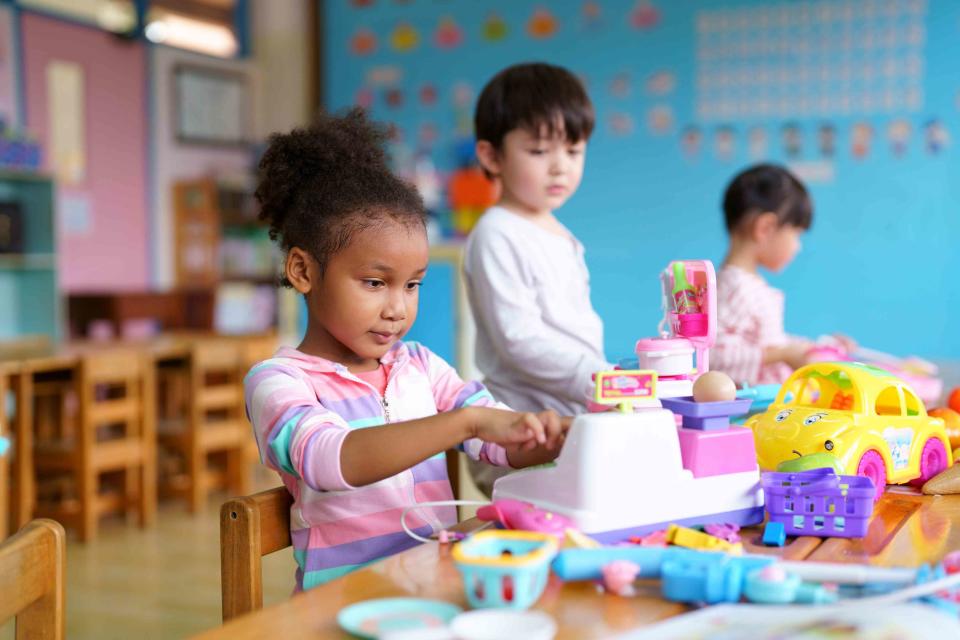Preschool Access Is Getting Harder and It’s Worse in Certain States, New Report Finds
Your location might determine just how great your 3- or 4-year-old’s education is.

GettyImages/wera Rodsawang
Fact checked by Sarah Scott
If your 3- or 4-year-old lives in Maine versus Florida versus California, you might see a widely differing quality and level of access to preschool education. A new analysis from the National Institute for Early Education Research (NIEER) shows significantly different experiences based on geography, and the gap is widening while some areas make progress, and others lag behind.
The organization’s press release accompanying the report, published April 18, 2024, says state and national lawmakers have some “critical choices” to make on this issue.
Allison Friedman-Krauss, PhD, lead author of the report, tells Parents that as a mom to a 5- and 3-year-old, she’s seen firsthand how challenging understanding preschool options can be.
“One challenge is simply trying to understand the difference between child care, private-pay preschool, and state-funded preschool—also known as pre-k,” she says. “Child care originates in the need for parents to have someone watch their children so they can go to work or school, whereas preschool is an educational program for children before they enter kindergarten.”
The NIEER report is examining free, public, state-funded preschools in particular, where there are equity issues in access based on location. For example, in some parts of the country, there is only $2,000 spent on each preschooler, and in other parts it’s $16,000—a wide difference in resources.
And some states do not enroll any students in universal preschool, or ones that are publicly funded. The report shows states, including Idaho, Wyoming, South Dakota, Montana, Indiana, and New Hampshire, do not enroll 4-year-olds in universal preschool. When it comes to access for 3-year-olds, those states and several more, such as Florida, Georgia, Alabama, Mississippi, North Carolina, Maine, Michigan, Nevada, and North Dakota, do not enroll any.
The report shows that 16 states and the District of Columbia are committed to offering free public preschool, but that most of those aren’t meeting benchmarks to ensure their quality. Only five states meet NIEER’s benchmarks for the students they do serve: Alabama, Hawaii, Michigan, Mississippi, and Rhode Island.
“For example, what are the class size limits and adult-child ratios?” Dr. Friedman-Krauss says. “Small class sizes allow teachers to better attend to the needs of every child in the classroom and provide purposeful learning experiences.”
She adds that another important quality is having a lead teacher with at least a Bachelor’s degree in early childhood education or child development. In some places where it’s hard to find qualified teachers, this is not always the case.
In addition, NIEER outlines the national quality standards, policies, and benchmarks preschools should strive for, which can also help parents select a preschool in their search, or decide if their public preschool is high quality, including:
Early learning childhood and development standards should be comprehensive, aligned, supported, and culturally sensitive
Curriculum supports should include an approval process and support
Teachers should have a Bachelor’s degree
Assistant teachers should have a Child Development Associate (CDA) credential or equivalent
Teachers and assistants should have at least 15 hours per year, and there should be individual professional development plans as well
Classes should have 20 children or less
Staff-child ratio should be 1 adult per 10 children or better (this means having at least a lead and assistant teacher)
Screening and referrals should include visual, health, and hearing
There should be structured classroom observations and data used for program improvement
In addition, the early childhood development organization Zero to Three shares with Parents some signs of a high quality preschool, including safety first policies and procedures, and being able to see relationships in action.
“Teachers are on children’s level, sitting on the floor, for example. They are caring and friendly with children, and engage in back-and-forth conversations with children, even those who aren’t yet old enough to answer back,” they share in a statement. “You should see how teachers engage with individual children—jokes, a game, a hug, or a short conversation—since these individual relationships matter so much to children.”
Further, teachers should comfort children who seem hurt or distressed, and not shame or frighten them. Kids should also seem joyful, and lessons should be play-based.
The researchers state in the NIEER press release that preschool can improve kindergarten readiness, laying the foundation for later education as well. But of course, while caregivers can research what programs they can send their children to and support them at home, a lot is out of their hands. The report leaves important questions for legislators, especially on how to make progress toward high-quality universal preschools.
Dr. Friedman-Krauss shares some of those in the press release: “Will programs serve both 3- and 4-year-olds? Will investments be enough to ensure that programs are effective? Will states support an equitable mixed-delivery model for preschool incorporating both existing child care programs and public schools? How will states recruit, support, and retain preschool teachers?
Bottom line, adds Dr. Friedman-Krauss, "These decisions will impact millions of children for years to come.”
For more Parents news, make sure to sign up for our newsletter!
Read the original article on Parents.

